Yoga offers a diverse range of programs designed to improve flexibility, catering to various skill levels and personal preferences. By addressing common misconceptions and focusing on consistent practice, individuals can effectively overcome flexibility limitations and discover the style that best suits their needs. Whether through Hatha, Vinyasa, or Restorative yoga, the journey towards enhanced flexibility and overall well-being begins with the right approach.
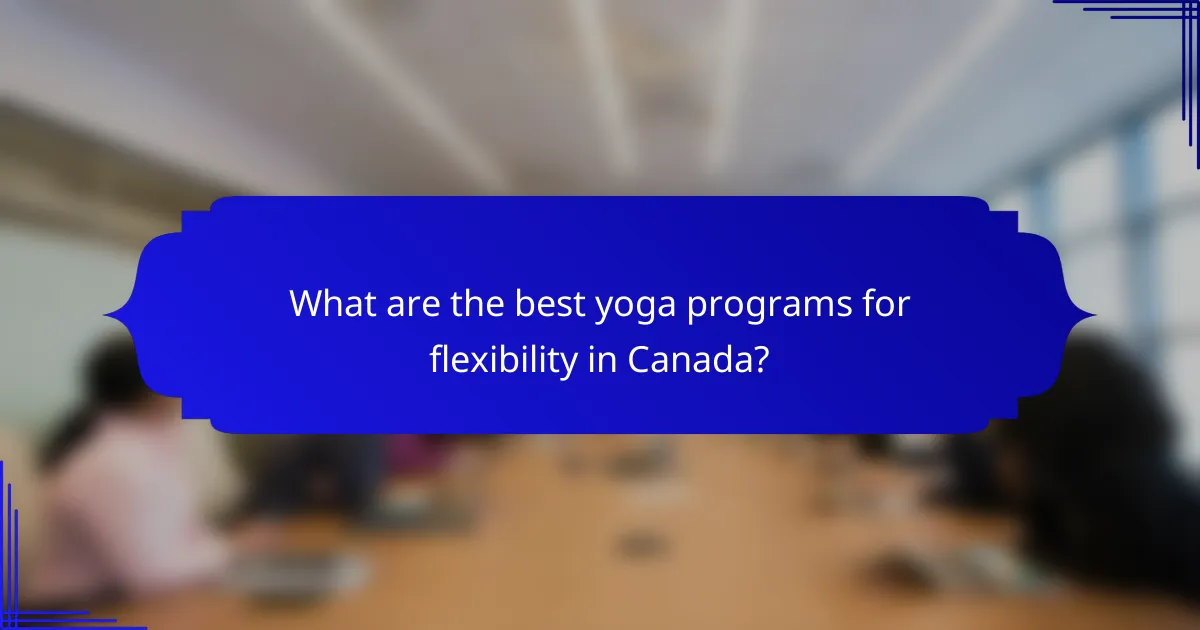
What are the best yoga programs for flexibility in Canada?
The best yoga programs for flexibility in Canada include styles that cater to various skill levels and preferences. Hatha, Vinyasa, and Restorative yoga are popular choices that help improve flexibility while addressing different needs and goals.
Hatha yoga for beginners
Hatha yoga is an excellent starting point for beginners looking to enhance their flexibility. This style focuses on basic postures and breathing techniques, allowing practitioners to develop strength and balance while gradually increasing their range of motion.
Classes typically involve slower-paced sequences, making it easier to learn proper alignment and technique. Beginners should look for classes labeled as “gentle” or “beginner-friendly” to ensure a supportive environment.
Vinyasa yoga for dynamic stretching
Vinyasa yoga offers a more dynamic approach to flexibility through flowing sequences that connect breath with movement. This style encourages practitioners to transition smoothly between poses, promoting greater flexibility and strength in a more energetic setting.
Classes can vary in intensity, so it’s advisable to choose sessions that match your fitness level. Look for classes that emphasize fluid movement and breath coordination to maximize the benefits of dynamic stretching.
Restorative yoga for deep relaxation
Restorative yoga focuses on relaxation and recovery, using props to support the body in gentle poses. This style is particularly beneficial for increasing flexibility by allowing muscles to release tension and stretch deeply without strain.
Classes typically involve longer holds in poses, promoting deep relaxation and mental clarity. Practitioners should seek out sessions that emphasize restorative techniques to fully experience the benefits of this calming practice.
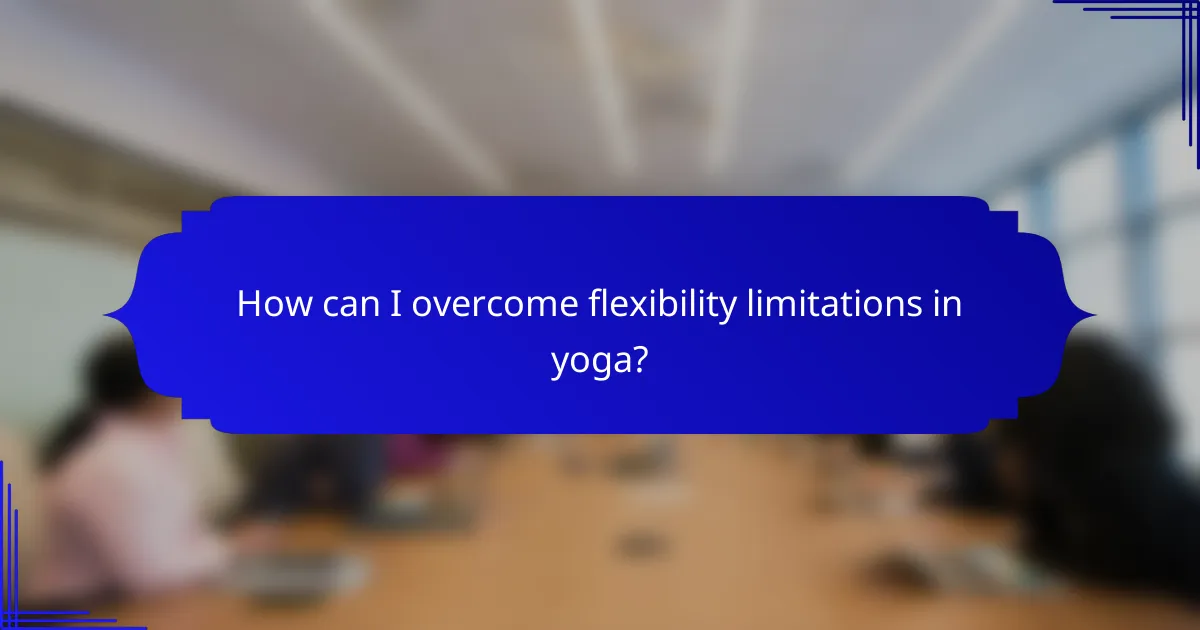
How can I overcome flexibility limitations in yoga?
To overcome flexibility limitations in yoga, it’s essential to adopt a consistent practice that includes various techniques tailored to your body. This approach not only enhances your range of motion but also builds strength and stability over time.
Incorporating regular stretching routines
Regular stretching routines are vital for improving flexibility. Aim to incorporate dynamic stretches before your yoga sessions and static stretches afterward. A good practice is to dedicate at least 10-15 minutes daily to stretching, focusing on major muscle groups like hamstrings, quadriceps, and shoulders.
Consider using a combination of both passive and active stretching techniques. Passive stretching involves holding a position with the help of gravity or a partner, while active stretching engages your muscles to hold the position. This variety can significantly enhance your flexibility over time.
Using props like blocks and straps
Yoga props such as blocks and straps can greatly assist in overcoming flexibility limitations. Blocks help you reach the ground in poses where your hands may not comfortably touch, while straps can aid in extending your reach during stretches. Using these tools allows you to maintain proper alignment and deepen your stretches safely.
When using props, start with a comfortable height for blocks and adjust as needed. For straps, loop them around your foot or hand to help you hold positions longer without straining. This approach not only enhances flexibility but also builds confidence in your practice.
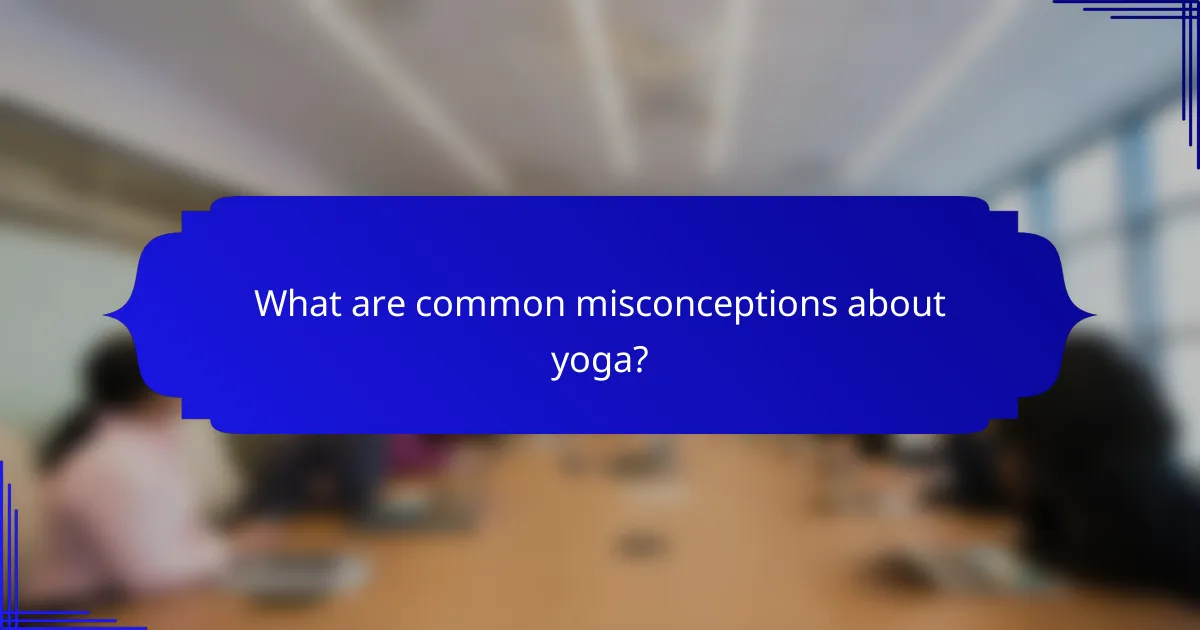
What are common misconceptions about yoga?
Many people hold misconceptions about yoga that can prevent them from exploring its benefits. Understanding these myths is crucial for anyone considering starting a yoga practice.
Yoga is only for flexible people
A prevalent myth is that yoga is exclusively for those who are already flexible. In reality, yoga is accessible to everyone, regardless of their current flexibility level. Most styles of yoga encourage gradual improvement and focus on personal progress rather than achieving perfect poses.
Beginners often find that yoga helps increase their flexibility over time. Many classes cater to all skill levels, emphasizing modifications and props to support individual needs. For instance, using blocks or straps can make poses more achievable for those with limited flexibility.
All yoga styles are the same
Another common misconception is that all yoga styles are identical. In fact, there are numerous styles, each with its unique focus and approach. For example, Hatha yoga emphasizes basic postures and breathing techniques, while Vinyasa is more dynamic, linking breath with movement.
When choosing a style, consider your goals and preferences. If you’re looking for relaxation, Yin yoga might be suitable, whereas if you prefer a more vigorous workout, Ashtanga or Power yoga could be a better fit. Exploring different classes can help you find the right match for your needs and enhance your overall experience.
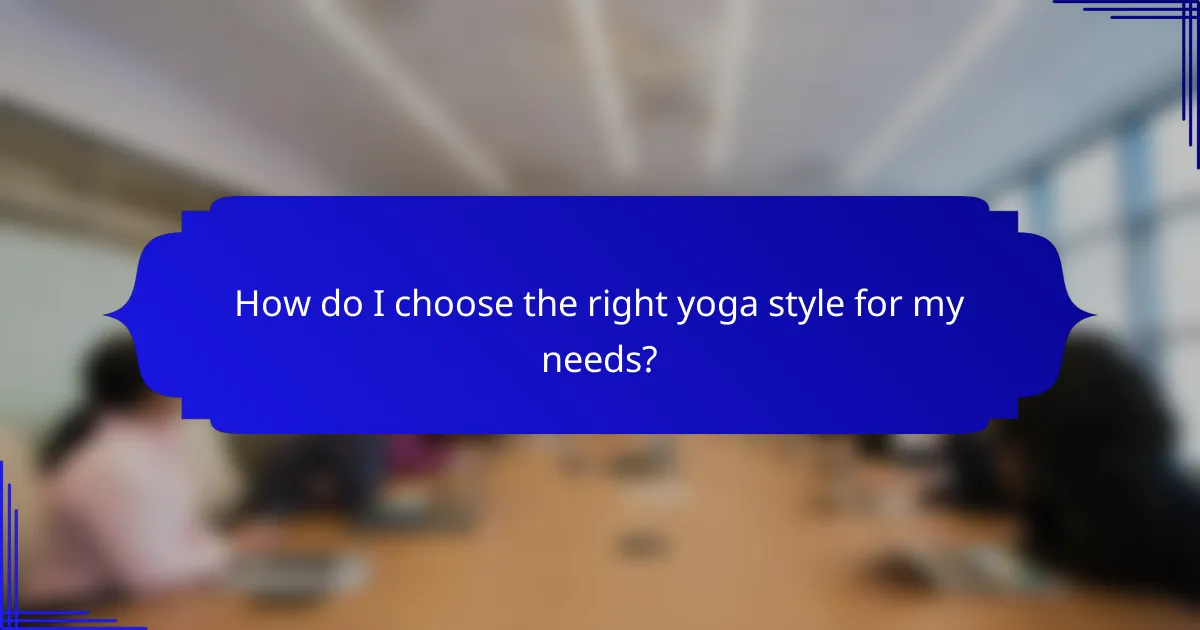
How do I choose the right yoga style for my needs?
Choosing the right yoga style involves understanding your personal fitness goals and any physical limitations you may have. By assessing these factors, you can select a practice that aligns with your needs and enhances your well-being.
Assessing personal fitness goals
Start by identifying what you want to achieve through yoga. Common goals include improving flexibility, building strength, reducing stress, or enhancing mindfulness. For instance, if your primary aim is to increase flexibility, styles like Hatha or Yin yoga may be more suitable.
Consider how much time you can dedicate to practice each week. If you can commit to several sessions, a more intensive style like Ashtanga might be beneficial. Conversely, if your schedule is tight, gentler practices like Restorative yoga can provide relaxation without demanding extensive time.
Considering physical limitations
Recognizing your physical limitations is crucial in selecting a yoga style. If you have injuries or chronic pain, opt for gentler styles that focus on alignment and restorative poses, such as Iyengar yoga. These approaches allow for modifications and support safe practice.
Consult with a healthcare provider if you have specific health concerns. They can provide guidance on which yoga styles may be appropriate for your condition. Additionally, many studios offer beginner classes that cater to those with limitations, ensuring a supportive environment for your practice.
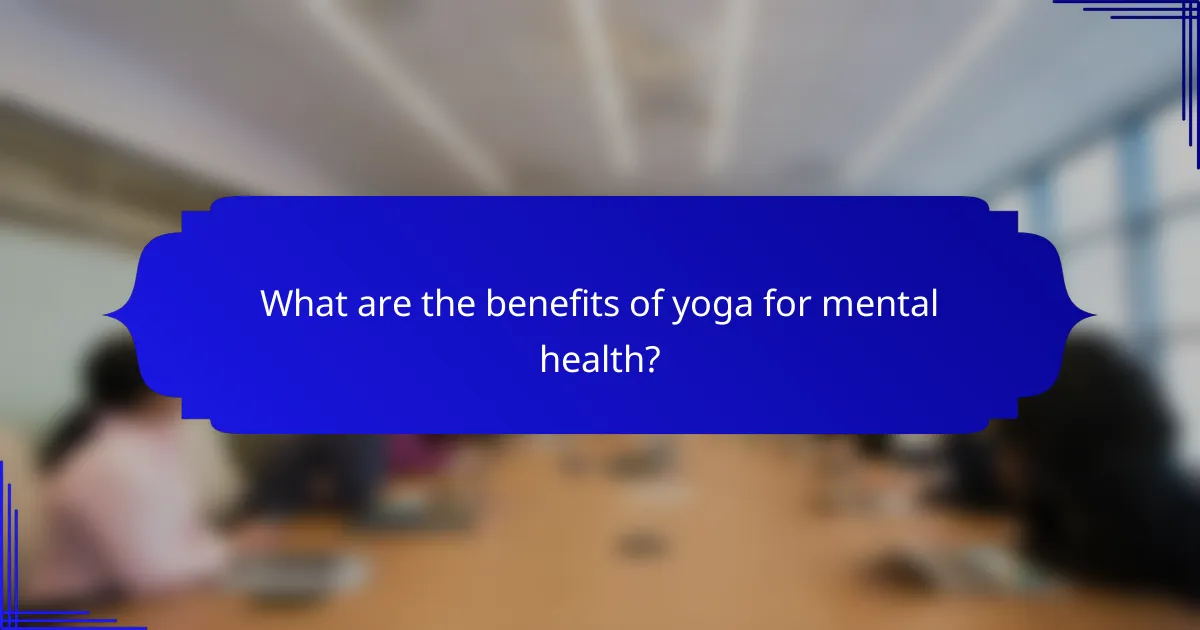
What are the benefits of yoga for mental health?
Yoga offers numerous benefits for mental health, including enhanced emotional well-being and reduced symptoms of stress and anxiety. By combining physical postures, breathing techniques, and meditation, yoga promotes relaxation and mental clarity.
Reducing stress and anxiety
Yoga can significantly reduce stress and anxiety levels by promoting relaxation and mindfulness. When practicing yoga, individuals often experience a decrease in cortisol, the stress hormone, leading to a calmer state of mind.
Incorporating specific poses, such as Child’s Pose or Legs-Up-the-Wall, can help alleviate tension and foster a sense of peace. Regular practice, even for just 15-30 minutes a few times a week, can yield noticeable improvements in stress management.
Improving focus and mindfulness
Yoga enhances focus and mindfulness by encouraging practitioners to concentrate on their breath and body movements. This focus helps to quiet the mind, making it easier to stay present and engaged in daily activities.
Techniques such as mindful breathing and meditation during yoga sessions can sharpen cognitive function and improve attention span. To maximize these benefits, aim to practice yoga consistently, integrating mindfulness exercises into your routine.
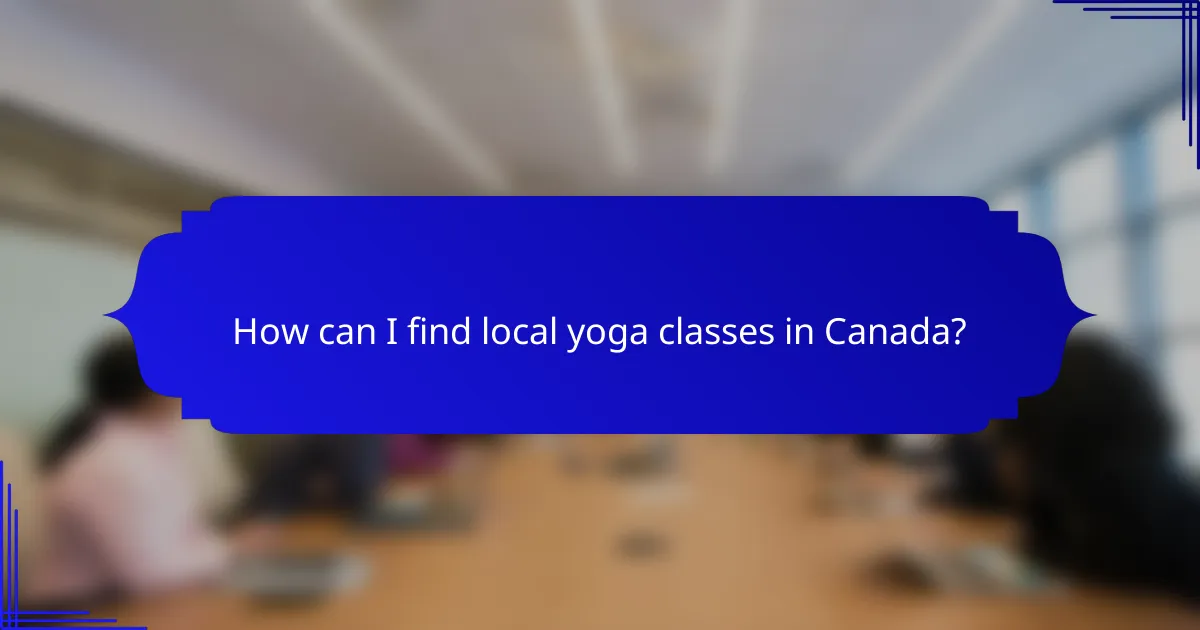
How can I find local yoga classes in Canada?
To find local yoga classes in Canada, start by searching online directories and community resources. Many cities have dedicated platforms that list available classes, making it easier to discover options that suit your schedule and preferences.
Using online class directories
Online class directories are a convenient way to locate yoga classes in your area. Websites like Yoga Alliance, Mindbody, or even Google Maps can help you find studios and instructors nearby. You can filter results based on class types, skill levels, and user reviews.
When using these directories, pay attention to the class descriptions and schedules. Some platforms allow you to book classes directly, which can save time and ensure you secure a spot in popular sessions.
Checking community centers and studios
Community centers and local studios often offer yoga classes at reasonable rates. Many of these venues provide a variety of styles, from Hatha to Vinyasa, catering to different skill levels. Visiting their websites or calling directly can give you up-to-date information on class times and pricing.
Consider checking bulletin boards or newsletters in your neighborhood as well. Many community centers post schedules and special events, which can include workshops or introductory classes that are budget-friendly.
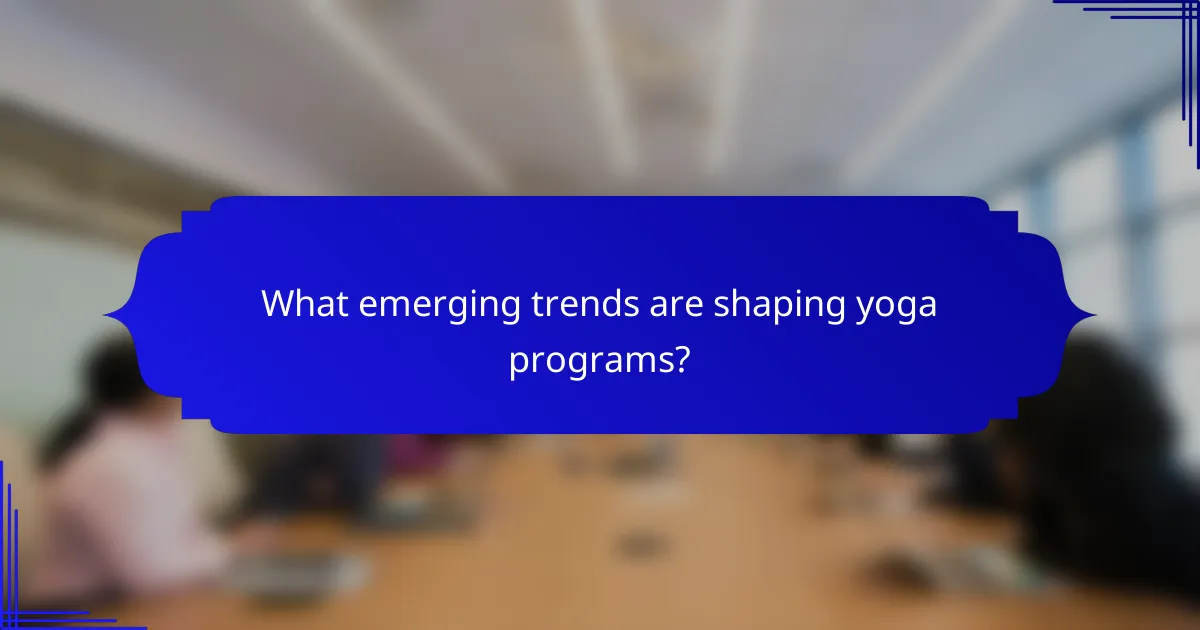
What emerging trends are shaping yoga programs?
Emerging trends in yoga programs focus on inclusivity, technology integration, and specialized practices. These trends aim to cater to diverse populations, enhance accessibility, and provide tailored experiences for practitioners.
Flexibility limitations
Flexibility limitations are common concerns for many individuals starting yoga. It’s essential to understand that yoga is not solely about achieving extreme flexibility; rather, it emphasizes gradual improvement and body awareness. Practitioners should focus on their own progress rather than comparing themselves to others.
To work within flexibility limitations, consider starting with gentle styles such as Hatha or Yin yoga. These approaches allow for slower movements and deeper stretches, making them suitable for beginners or those with tight muscles. Always listen to your body and avoid pushing beyond comfortable limits.
Misconceptions
Many misconceptions about yoga can deter potential practitioners. A prevalent myth is that yoga is only for the young and flexible. In reality, yoga is adaptable for all ages and body types, with modifications available for various abilities.
Another common misconception is that yoga is merely a physical workout. While it does improve strength and flexibility, yoga also encompasses mental and emotional benefits, such as stress reduction and enhanced mindfulness. Understanding these aspects can help individuals appreciate the full value of yoga.
Finding the right style
Finding the right yoga style is crucial for a fulfilling practice. With numerous styles available, it’s important to explore options that align with personal goals and preferences. Beginners might consider trying Hatha, Vinyasa, or Restorative yoga to determine what resonates best.
To make an informed choice, consider factors such as desired intensity, pace, and focus areas. For instance, if you seek a physically demanding workout, Ashtanga or Power yoga may be suitable. Conversely, if relaxation is your goal, look for classes labeled as Yin or Restorative. Attending a few trial classes can help clarify your preferences.
